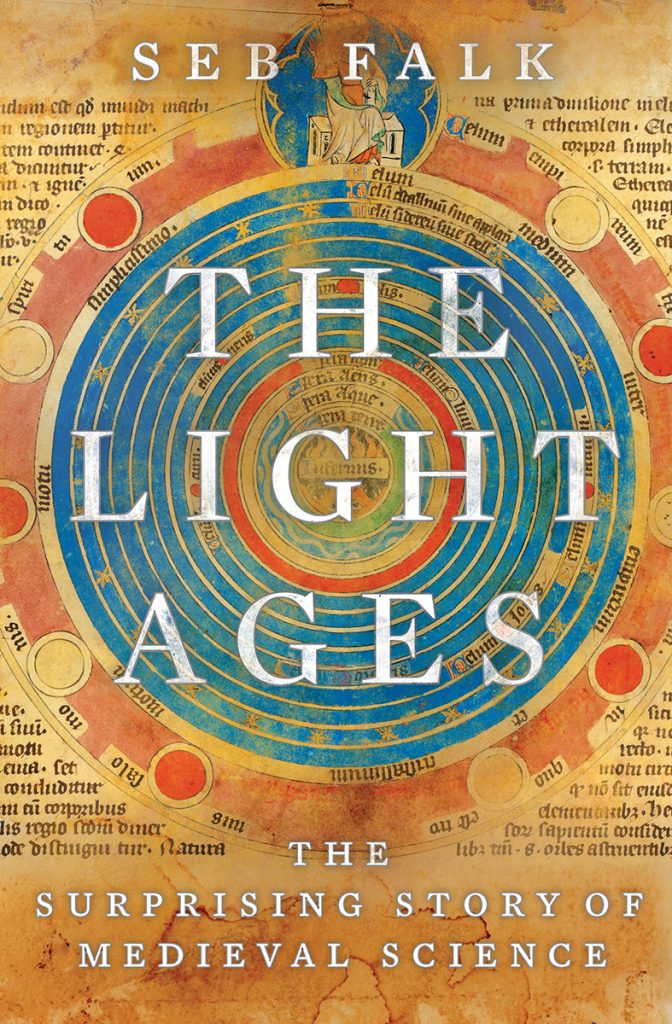The Light Ages came out in the autumn, and got squeezed off my reading schedule by A Life on Our Planet. I apologise to the publishers and Netgalley for this, and hope it won’t count against me too much.
The cover picture for this book is larger than usual, since it deserves being able to be seen (click it to enlarge). The detail in this book accounts for the extraordinarily long gap between starting and finishing it: I put it aside until I had time for more concentration.
The Light Ages: The Surprising Story of Medieval Science

An illuminating guide to the scientific and technological achievements of the Middle Ages through the life of a crusading astronomer-monk.
Soaring Gothic cathedrals, violent crusades, the Black Death: these are the dramatic forces that shaped the medieval era. But the so-called Dark Ages also gave us the first universities, eyeglasses, and mechanical clocks, proving that the Middle Ages were home to a vibrant scientific culture.
In The Light Ages, Cambridge science historian Seb Falk takes us on an immersive tour of medieval science through the story of one fourteenth-century monk, John of Westwyk. From multiplying Roman numerals to navigating by the stars, curing disease, and telling time with an ancient astrolabe, we learn emerging science alongside Westwyk, while following the gripping story of the struggles and successes of an ordinary man in a precarious world. An enlightening history that argues that these times weren’t so dark after all, The Light Ages shows how medieval ideas continue to color how we see the world today.[goodreads]
My Review
History of science interests me, but I dropped history at school. It is probably unsurprising that I have always been mystified by the term ‘the Dark Ages’. Cambridge historian Seb Falk obviously felt there was a need to change people’s opinions of this period. There is no doubt from his research: this era was a hotbed of scientific thought, and wondrous inventions. He also shows the international collective reasoning that tried to establish the why and how of our world.
This tour de force of a book collects evidence across several centuries. Falk often delves into obscure original manuscripts, or contemporary copies. Notes, references and further commentary take up 20% of the book’s length. That may help you as you start tackling the vagaries of addition and multiplication in Roman numerals. That was the common practice at the start of this period. Introducing Indo-Arabic numbers must have been a bigger revolution than decimalisation! I can multiply in pounds, shillings and pence, and in stones, pounds and ounces. We learnt this in primary school. You may well be completely baffled by the monk’s way of counting: in 60s – the quinquegessimal system. I sort of got the hang of it, but at a cost of completely losing the plot of the book. And I think this was still chapter one.
John of Westwyk
The problem with the book? The ease in which the author dives from one subject to another, in very long chapters. When you reflect on the whole they make some sense, but at the time of first reading, seem completely random. Yes, he is taking the obscure monk John of Westwyk. He is filling in the world he lived in as he moves through his monkish path. But he leaps from Chaucer (with quotes in Chaucerian English), to the Pope of the time, and then his twice removed predecessor. These are trials of memory and understanding. These may have been taxed enough by the detailed examination of copying manuscripts, or the role of an Arabic scientist in learning to build armillary spheres.
By the time we got to the summing up–which I recognised as such, because I suddenly understood what he’d been talking about beforehand–I had long since lost enthusiasm. The problem is, I think, that as the author says: schools teach the Dark Ages simply as strings of kings and battles, with occasional explanation of why they were fighting. This was probably a Victorian invention (along with ‘not invented here’ which wiped out the Islamic contribution). It turns out (to me, you probably know this) that the Crusades were entirely driven by the Catholic popes. By the time of the crusade that our monk John went on, the Pope was paying them in remission of sins (i.e. ticket to heaven) for participation in a war against people who merely disagreed with the pope’s way of running the christian world. I’ve made that very simplistic.
Readability
So I did find the Light Ages interesting, but not as a whole. And it was very much worth switching from reading on my kindle, to reading on my app on my iPad. The illustrations changed from pretty much unintelligible, to something much better. I think as a reference book, this book belongs on the bookshelf. I recommend all libraries – and all school, college and science libraries, hold at least one copy. After all, if it wasn’t for Seb Falk, Merton College library would still have one of the priceless contemporary copies of an early scientific instrument consigned to a cupboard and labelled ’round table?’
One for science and history enthusiasts, but check out an ebook copy visually before you buy it.



Thanks for sharing your thoughts on this.
Here’s hoping 2021 is a good one.
Sounds like a book I’d like to have around to dip into. I was once pretty immersed in the 12th-14th Centuries, though mostly in the British Isles. Not sure about reading it right through, though, from what you say!
I think if you have it with no time pressures, you’d enjoy it. It is fascinating in smaller chunks than I read it in. Maybe I should get a copy for the shelf. The trouble is, I think it might stay there now.